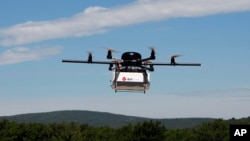Malawi's government on Thursday announced Africa's first drone air corridor to provide a controlled platform for drones to deliver needed services to communities.
Alfred Mtilatila, director of the Department of Civil Aviation, said the launch of the testing corridor is largely supported by UNICEF-Malawi as a pilot project using unmanned aircraft systems, or UAS, for transporting dried blood samples for the early diagnosis of HIV in infants.
"We would like to establish a designated area where we will permit different types of unmanned aerial vehicles so that we will be able to come up with the right type of vehicles which can be used for different purposes," Mtilatila said.
In March, UNICEF-Malawi successfully completed its first test flight of the 10-kilometer route from a community health center to the Kamuzu Central Hospital in the capital, Lilongwe.
Currently, Malawi uses motorcycles or locally run ambulances to transport blood samples.
But health authorities say high fuel costs and the poor state of roads mean long delays in deliveries.
"Malawi has over the past years faced serious droughts and flooding. … The launch of the UAS testing corridor is particularly important to support transportation and data collection where land transport infrastructure is either not feasible or difficult during emergencies," Jappie Mhango, Malawi's minister of Transport and Public Works, said in a statement.
A recent study by UNICEF-Malawi shows that it currently takes an average of 11 days to get samples from a health center to a testing lab, and up to four weeks for the results to be returned.
The report also shows that the delay between test and results has led to a higher number of patients not receiving timely treatments.
Judith Sherman, chief of the HIV and AIDS section at UNICEF-Malawi, told VOA that the drones project could resolve that problem.
"Since some of the health facilities are in remote areas, it takes a while for motorbikes to actually reach these facilities,” Sherman said. “And during the rainy season, roads are difficult to go on and bridges are easily washed away. So the idea was, ‘Can these drones be introduced to help complement the motorbike system?’"
After its second test flight, the drone corridor is expected to run for a maximum distance of 40 kilometers and become fully operational by April 2017.











